Frequently asked questions and answers for Power Supplies - Industrial Automation
What happens when the Power Supplies reach their life expectancy?
The internal electrolytic capacitor deteriorates over time and eventually the output voltage drops to the point where the Power Supplies cannot output power.
What happens when the Power Supplies reach their life expectancy?
The internal electrolytic capacitor deteriorates over time and eventually the output voltage drops to the point where the Power Supplies cannot output power.
What is the maintenance forecast monitor on S8VS Switch Mode Power Supply?
As time passes, the characteristics of the electrolytic capacitor inside the Power Supply deteriorate. The maintenance forecast monitor indicates the approximate time that is left until the Power Supply will stop performing sufficiently, by calculating the deterioration of the electrolytic capacitor.
Example Using S8VS-06024A

As a guideline, replace the Power Supply within one month when the remaining years reaches 0.0 years.
Example Using S8VS-[][][]24A (Excluding S8VS-06024A)
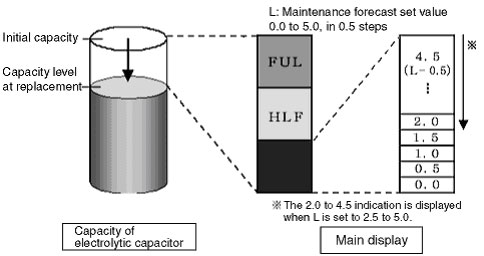
As a guideline, replace the Power Supply within one month when the remaining years reaches 0.0 years.
Example Using S8VS-06024A

As a guideline, replace the Power Supply within one month when the remaining years reaches 0.0 years.
Applicable model: S8VS-[][][]A
Model numbers with the suffix "A" are equipped with the maintenance forecast monitor.
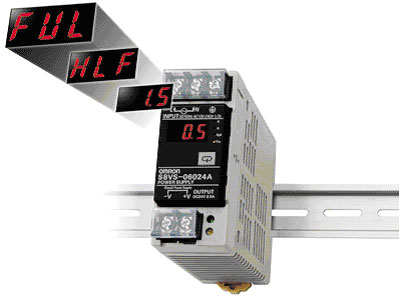
What is the best way to estimate the amount of heat produced by the Power Supply?
The Power Supply's internal loss becomes heat energy (internal loss = heat produced).
Equations:
Internal loss (W) = Effective input power - Output power
= Output power/Efficiency - Output power
Example Calculating the Heat Produced by a 100-W S82K Switch Mode Power Supply
Power rate: 80%
Output power: 24 V × 4.2 A = 100.8 W
Effective input power: Output power/Efficiency = 100.8 W/80% = 126 W
Internal loss (heat produced): 126 W - 100.8 W = 25.2 W
To convert the internal loss to calories:
By Joule's law, 1 W = 0.24 cal/s,
so 25.2 W = 25.2 × 0.24 cal/s = 6.05 cal/s
What would be the cause and countermeasures for an input breaker tripping or an external fuse blowing?
The breaker may have tripped due to the inrush current from the power supply.
Confirm the inrush current for each product, then provide fuses and breakers to match. (The power supply inrush current can be from several times to several tens of times higher than the current during normal operation.)
Why does the output indicator light only dimly?
The overcurrent protection may be operating because the load on the power supply is exceeding the rated value. Either reduce the load, or provide a power supply with sufficient capacity to handle the current of the load.
How long does the inrush current from the Power Supply continue to flow?
About 5 ms as a general rule. An inrush current will occur regardless of the load, even when there is no load.
When the power is turned ON for a Switching Power Supply, a peak current flows to charge the input smoothing capacitor. This is called inrush current.
The inrush current value depends on the timing at which the power is turned ON, and on the inrush current prevention circuit, but it can be anywhere from several times to several tens of times higher than the input current during normal operation.
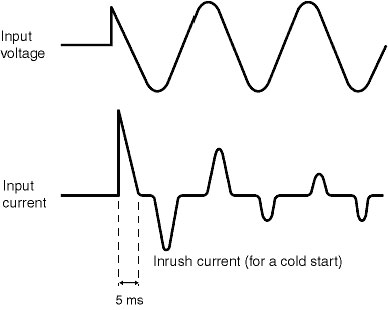
The output LED indicator is not lit and the output will not go ON.

I measured the output voltage with a tester and it is lower than the rated voltage. Can the output voltage be adjusted?
Although there are +/- output models that cannot be adjusted, the output from most Power Supplies can be adjusted by turning the voltage output adjuster (V.ADJ).
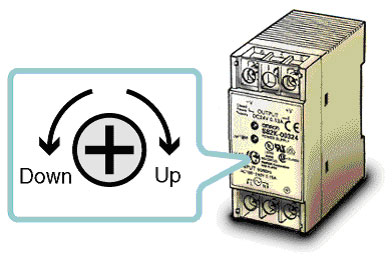
The voltage will increase when the adjuster is turned clockwise.
The voltage will decrease when the adjuster is turned counterclockwise.
The ranges in which the voltage can be adjusted are as follows:

What is parallel operation?
When a load's current requirements cannot be met with one Power Supply, two or more Power Supplies can be connected in parallel to increase the output current. This configuration is known as parallel operation.
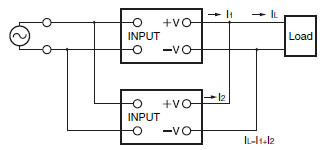
There are Power Supplies listed with a "Class 2" UL rating. What is the "Class 2" rating?
The UL Class 2 Power Units standards apply to power supplies within a limited output current and output voltage range.
The Class 2 standard is specified in UL Standard Number UL1310. In order to receive the UL Class 2 approval, the power supplies must pass UL testing as follows:
Furthermore, a benefit of using the power supplies that have received the Class 2 approval is that the output has the same Class 2 safety level. When applying for safety standards approval for the equipment, in some cases it is not necessary to obtain safety standard approval for the connected device (load) when the device (load) is connected to the output of a power supply that has received Class 2 approval.
What is overload protection function?
This protection function prevents damage to the Power Supply itself due to overcurrent (including output short-circuits). The protection function is activated and the output current is limited when the load current is greater than the overcurrent detection value (this value depends on the model).
The output voltage will also drop according to the overload (load impedance).
The drop level depends on the overload conditions and load line impedance.
The following table shows the six types of output voltage drop characteristics for main models when the overcurrent protection function is operating.
These drop characteristics can be seen as indicating the limit on the output current that can be supplied to the load effectively in the process in which the output voltage starts when the AC input turns ON. When connecting a load (with built-in DC-DC converter) that starts operating from a low voltage or a capacitive load in which inrush current can flow easily, consider the trend in overcurrent protection drop characteristics and the startup characteristics on the load side when selecting the Power Supply.
Generally, an inverted L voltage drop is considered favorable at startup.

Applicable Models: All Models
What are switching power supplies?
Switching power supplies input a commercial AC power supply (such as 110 VAC or 220 VAC), uses a high-speed semiconductor switching process to convert the input to high-frequency electric power, and yields a direct current (such as 24 VDC).
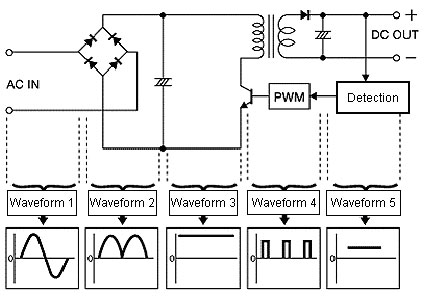
What precautions are necessary when mounting more than one S82J or S82K Power Supply?
Space must be provided between Power Supplies to allow heat to dissipate when more than one Power Supply is installed side by side. Convection currents is used to cool Power Supplies. (Whenever possible, use forced cooling.)
S82J
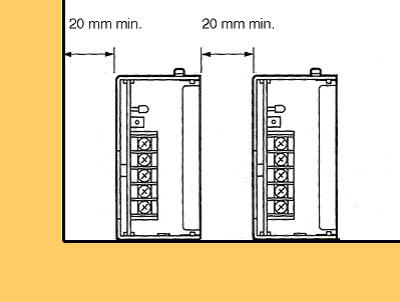
Note:Whenever possible, install Power Supply on metal plates.
For 300-W and 600-W Power Supplies, space must be provided in front of and behind Power Supplies as well.

S82K
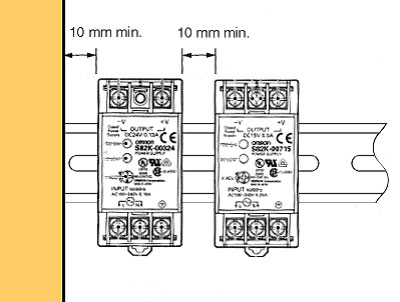
What is the proper wiring method to use when wiring the input and output?
We recommend wiring Power Supplies with the following method in order to minimize noise.
Separate input lines and output lines, and use twisted cables.
Noise will be induced on the output lines if they are laid together with or close to input lines.

Use short, thick input lines.
Input lines radiate noise, and must therefore be as short and thick as possible.

Do not loop input or output lines.
Loops in lines can radiate noise to other devices or can function as antennas inducing highfrequency noise.

Use short, thick ground wires.
The damping effect of the noise filter built into the Power Supply will be reduced if a long ground wire is used. Always make ground wires as short and as thick as possible.

Connect a noise filter.
Include a noise filter on the input side of the Power Supply if faulty operation in electric circuits connected to the output from the Power Supply are being caused by sources of surge on the AC input line, such as large magnetic relays.
Ground the noise filter with a thick, short wire.

Use shielded cables for the remote sensing and remote control signal lines.
Remote sensing and remote control signal lines must always be wired separately using shielded cables to prevent faulty operation caused by the induction of noise. Noise can be induced when these signal lines are laid together with input lines or power lines, which often carry noise.

What factors should be considered when selecting Power Supplies?
Select Power Supplies based on the following factors.
1) What are Power Supplies' input voltage specifications?
Example:
When the input voltage is 100 VAC, select a model with a 100 to 240 VAC range or automatic selection of 100 or 200 VAC.
2) What are the load's DC voltage specifications?
Example: Select a DC voltage such as 12 VDC or 24 VDC.
3) What is Power Supplies capacity requirement?
Example:Select Power Supplies so that the maximum load capacity is less than the Power Supplies' output capacity
4) What is the mounting location and mounting method?
Example:If it is important to save space in a control panel and Power Supplies will be mounted to a DIN Track, use Power Supplies such as the S8VS or S82K
5) Are advanced functions required?
You want to display the output current and monitor when Power Supplies are due for replacement.
→ S8VS Series
You want to use the remote sensing and remote control functions
→ S82L, etc.
You want Power Supplies to support peak loads.
→ S82F-P Series
You want to use the overload protection function.
→ S82J (most models), S8TS, S8VS, S8PS, etc
You want to backup operation with batteries if the AC power input is interrupted.
→ S8TS Series or S8T-DCBU-01
You want the use the output voltage detection alarm function.
→ S82K-[][][][][]T, S8VS, S8TS, etc.
Do you have any Power Supplies that support backup operation (i.e., using redundant Power Supplies)?
Yes. Backup operation is possible for all models of Power Supply except for those with multi-output capability.
What would happen if you mistakenly Short-circuit output terminals?
The overload protection function would operate to limit the output current.
What would happen if you operate Power Supplies in parallel that are not capable of parallel operation?
A malfunction would occur because a load current imbalance would cause the Power Supplies to exceed the rated output current.
Are there models available that support series operation?
The following table shows the models that support series connection of outputs.
Models Supporting Series Connection of Outputs

Diode type: Schottky barrier diode
Dielectric strength (VRRM): At least twice the Power Supply's rated output voltage
Forward current (IF): At least twice the rated output voltage of the Power Supply
Are there any Power Supplies that use a battery as backup for momentary power interruptions?
S8TS Block-type Switch Mode Power Supply (24-VDC output) and S8T-DCBU-01 DC Backup Block for S8TS can be combined with the specified battery to prevent the 24-VDC output from turning OFF during a momentary power interruption.
Depending on the battery used, this combination provides up to 8 A of power, greatly improving system reliability.

Is Power Supplies' input side (primary) isolated from the output side (secondary)?
The primary and secondary are isolated by a transformer and photocoupler. The ground is separated from the internal circuit by capacitors.
Example: Block Diagram of S82J-050[][][][] (50 W) Switch Mode Power Supply

The fuse inside Power Supplies seems to have blown. Can I replace it myself?
No, this replacement must not be done by the user. In most cases where an internal fuse has burnt out, there is also damage to circuits inside Power Supplies. Do not attempt to do anything to Power Supplies, and ask your OMRON representative to repair them.
What is Series operation?
Series operation is a method of connecting Power Supplies to increase output voltage.Connect the outputs of two Power Supplies in series and wire the load to the ends.

What factors determine the electrolytic capacitor's service life?
Generally, the operating temperature is the most important factor.
Other factors that influence the service life include the applied voltage, ripple currents, and individual variations among electrolytic capacitors.
The factors were taken into consideration when designing S8VS Switch Mode Power Supply.
The output voltage decreased while Power Supplies are in use. What is the cause of the problem and solution?
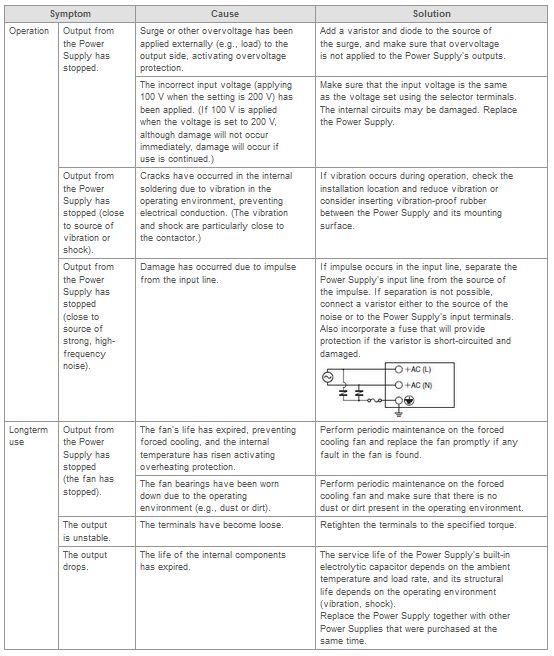
What is the life expectancy of Power Supplies?
Power Supplies' lifetime depends on its usage.
The life expectancy also depends on the model of Power Supplies being used, as shown in the following table. Use this information as reference for maintenance and replacement.
Conditions:

With S8VS Series Switch Mode Power Supply, the Maintenance Forecast Monitor Function will indicate the approximate time remaining until recommended replacement of Power Supplies.
What is Backup operation?
Backup operation is used when the output current from a single Power Supply is sufficient, but the system requires protection (backup) by another Power Supply in case the first Power Supply fails or is otherwise inoperative.
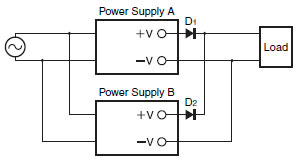
Use identical models for Power Supplies A and B.

What size load (as a percentage of Power Supplies' rated output capacity) can be connected to S82J or S82K Series Switch Mode Power Supply?
Generally speaking, it is possible to connect a load up to 100% of the rated output capacity (see note), but there are drawbacks. When Power Supplies are operated near their rated output capacity, inrush currents and load variations may trigger the overcurrent protection function, causing the output to stop and reducing the lifetime of Power Supplies. We recommend normal operation at about 70% to 80% of the rated capacity.
Are there models available that support parallel operation?
The following table shows the models that support parallel connection of outputs as well as the appropriate connection methods.

The output indicator turns ON, but then turns OFF immediately. What is the cause of the problem and solution (in models equipped with the overvoltage protection function)?
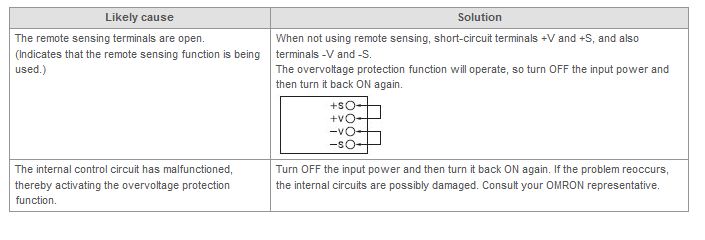
Do you have any UL-listed, Class 2-compatible Power Supplies?
We offer the following Class 2 Power Supplies with a UL 1310 listing.
Also, the sensors for Class 2 Power Supplies does not have to be UL listed. Standard sensors can be used.
The following Class 2 Power Supplies are available

Can S8VM Switch Mode Power Supply be operated in a parallel configuration?
It depends on the capacity.
Parallel operation is not possible for 15-W, 30-W, 50-W, 100-W, and 150-W Power Supplies.
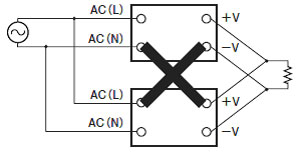
Parallel operation is possible for 300-W, 600-W, and 1500-W Power Supplies.
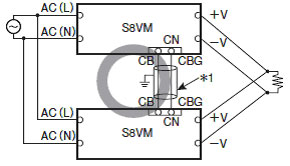
*1.Two-conductor shield wire